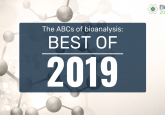GCC ICH M10: thoughts from Stephanie Cape

Stephanie Cape, PhD, is the Scientific Director of Bioanalytical Chemistry at Covance, Madison, WI.
She received her B.S. in Chemistry from University of Illinois Urbana–Champaign (IL, USA) in 2003 and her PhD in Analytical Chemistry from the University of Wisconsin–Madison (WI, USA) in 2007. Dr Cape’s graduate research was focused on developing high resolution mass spectrometric methods to enable discovery, characterization, imaging, and quantitation of neuropeptides.
Dr Cape joined the field of regulated Bioanalysis as a method development chemist. During her tenure at Covance (NJ, USA), she has served in a variety of leadership positions including oversight of study direction, validation, and method development. Additionally, Dr. Cape serves as a member of the Global Chemistry Solutions Strategy team contributing to scientific innovation.
1Why was there a need for the ICH M10 guidance, when there are already BMV guidance available?
Although the core principles of the current BMV guidance documents are aligned, regional specifics outlining the details create challenges and inefficiencies. Re-work and redundancies created by these differences contribute to the cost and time necessary to bring new drugs to market. One globally recognized BMV guidance will allow for better harmonization, standardization of processes and products, thus driving efficiencies and reducing time and cost. Additionally, the ICH M10 guidance has the potential to increase quality and compliance as it will become simpler for all to align with one global regulation.
2From a CRO perspective, was the draft guidance what you expected from a harmonized consensus guidance?
Yes, it is clear that the multiple viewpoints and experiences of the members of the expert working group were considered in creating the ICH M10 draft. Overall, the recommendations are aligned with previous guidance and regulatory expectations that have been shared with the industry. Subject matter experts have been working diligently in groups such as the GCC, AAPS, EBF, WRIB, etc., as well as within their individual companies to provide feedback, in some cases asking for clarification or suggesting modifications. With the incorporation of applicable refinements raised through the public consultation, the final document will clearly and thoroughly outline recommendations for BMV and sample analysis performed via chromatographic or ligand-binding assay in support of global submissions.
3Are there any disadvantages of such a collective consensus guidance, when used among different laboratories (e.g., Pharma, CROs, vendors etc.)?
Having one collective consensus guidance is a great advantage. The challenge will be in maintaining the global dialog necessary to ensure that the common understanding and agreement is maintained going forward.
4How easily can CRO’s adapt to implementing the ICH M10 guidance, while maintaining outsourcing standards?
For the most part, the expectations of the ICH M10 guidance are aligned with current CRO practices and could be implemented within a reasonably brief transition period to allow for update of SOPs, templates, training, etc. However, the report specifications in the current draft are onerous as the automation to enable some of these details to be included in the reports is not yet in place.
5How will the ICH M10 guidance change the bioanalytical regulatory landscape?
Setting globally harmonized expectations will enable the next phases of alignment in how bioanalytical data is collected and presented, which could provide significant gains in efficiency. This is also an important foundational step in positioning the regulatory authorities to streamline auditing by adopting mutually accepted data practices.





